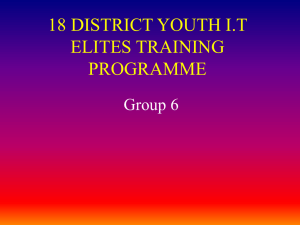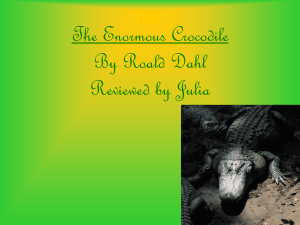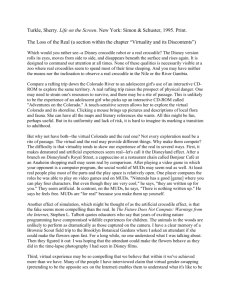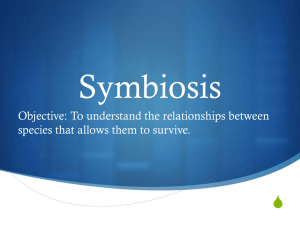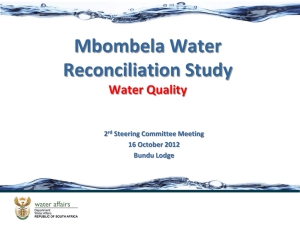being-prey - Remembering Val Plumwood
advertisement
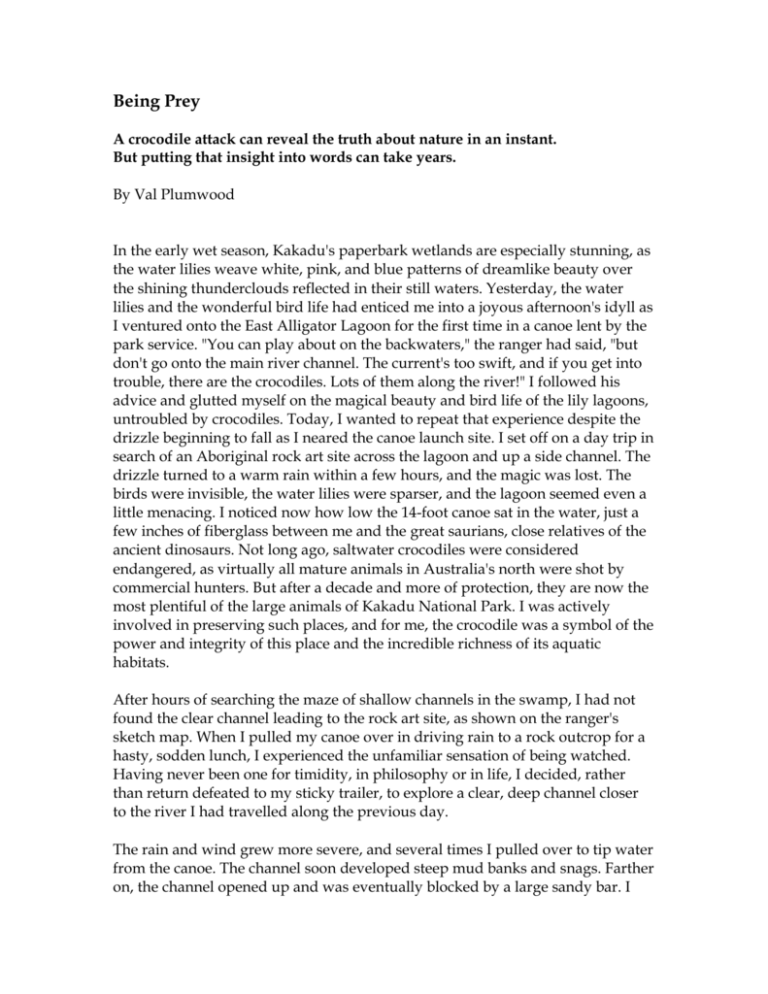
Being Prey A crocodile attack can reveal the truth about nature in an instant. But putting that insight into words can take years. By Val Plumwood In the early wet season, Kakadu's paperbark wetlands are especially stunning, as the water lilies weave white, pink, and blue patterns of dreamlike beauty over the shining thunderclouds reflected in their still waters. Yesterday, the water lilies and the wonderful bird life had enticed me into a joyous afternoon's idyll as I ventured onto the East Alligator Lagoon for the first time in a canoe lent by the park service. "You can play about on the backwaters," the ranger had said, "but don't go onto the main river channel. The current's too swift, and if you get into trouble, there are the crocodiles. Lots of them along the river!" I followed his advice and glutted myself on the magical beauty and bird life of the lily lagoons, untroubled by crocodiles. Today, I wanted to repeat that experience despite the drizzle beginning to fall as I neared the canoe launch site. I set off on a day trip in search of an Aboriginal rock art site across the lagoon and up a side channel. The drizzle turned to a warm rain within a few hours, and the magic was lost. The birds were invisible, the water lilies were sparser, and the lagoon seemed even a little menacing. I noticed now how low the 14-foot canoe sat in the water, just a few inches of fiberglass between me and the great saurians, close relatives of the ancient dinosaurs. Not long ago, saltwater crocodiles were considered endangered, as virtually all mature animals in Australia's north were shot by commercial hunters. But after a decade and more of protection, they are now the most plentiful of the large animals of Kakadu National Park. I was actively involved in preserving such places, and for me, the crocodile was a symbol of the power and integrity of this place and the incredible richness of its aquatic habitats. After hours of searching the maze of shallow channels in the swamp, I had not found the clear channel leading to the rock art site, as shown on the ranger's sketch map. When I pulled my canoe over in driving rain to a rock outcrop for a hasty, sodden lunch, I experienced the unfamiliar sensation of being watched. Having never been one for timidity, in philosophy or in life, I decided, rather than return defeated to my sticky trailer, to explore a clear, deep channel closer to the river I had travelled along the previous day. The rain and wind grew more severe, and several times I pulled over to tip water from the canoe. The channel soon developed steep mud banks and snags. Farther on, the channel opened up and was eventually blocked by a large sandy bar. I pushed the canoe toward the bank, looking around carefully before getting out in the shallows and pulling the canoe up. I would be safe from crocodiles in the canoe I had been told but swimming and standing or wading at the water's edge were dangerous. Edges are one of the crocodile's favourite food-capturing places. I saw nothing, but the feeling of unease that had been with me all day intensified. The rain eased temporarily, and I crossed a sandbar to see more of this puzzling place. As I crested a gentle dune, I was shocked to glimpse the muddy waters of the East Alligator River gliding silently only 100 yards away. The channel had led me back to the main river. Nothing stirred along the riverbank, but a great tumble of escarpment cliffs up on the other side caught my attention. One especially striking rock formation a single large rock balanced precariously on a much smaller one held my gaze. As I looked, my whispering sense of unease turned into a shout of danger. The strange formation put me sharply in mind of two things: of the indigenous Gagadgu owners of Kakadu, whose advice about coming here I had not sought, and of the precariousness of my own life, of human lives. As a solitary specimen of a major prey species of the saltwater crocodile, I was standing in one of the most dangerous places on earth. I turned back with a feeling of relief. I had not found the rock paintings, I rationalized, but it was too late to look for them. The strange rock formation presented itself instead as a telos of the day, and now I could go, home to trailer comfort. As I pulled the canoe out into the main current, the rain and wind started up again. I had not gone more than five or ten minutes down the channel when, rounding a bend, I saw in midstream what looked like a floating stick one I did not recall passing on my way up. As the current moved me toward it, the stick developed eyes. A crocodile! It did not look like a large one. I was close to it now but was not especially afraid; an encounter would add interest to the day. Although I was paddling to miss the crocodile, our paths were strangely convergent. I knew it would be close, but I was totally unprepared for the great blow when it struck the canoe. Again it struck, again and again, now from behind, shuddering the flimsy craft. As I paddled furiously, the blows continued. The unheard of was happening; the canoe was under attack! For the first time, it came to me fully that I was prey. I realized I had to get out of the canoe or risk being capsized. The bank now presented a high, steep face of slippery mud. The only obvious avenue of escape was a paperbark tree near the muddy bank wall. I made the split-second decision to leap into its lower branches and climb to safety. I steered to the tree and stood up to jump. At the same instant, the crocodile rushed up alongside the canoe, and its beautiful, flecked golden eyes looked straight into mine. Perhaps I could bluff it, drive it away, as I had read of British tiger hunters doing. I waved my arms and shouted, "Go away!" (We're British here.) The golden eyes glinted with interest. I tensed for the jump and leapt. Before my foot even tripped the first branch, I had a blurred, incredulous vision of great toothed jaws bursting from the water. Then I was seized between the legs in a red-hot pincer grip and whirled into the suffocating wet darkness. Our final thoughts during near-death experiences can tell us much about our frameworks of subjectivity. A framework capable of sustaining action and purpose must, I think, view the world "from the inside," structured to sustain the concept of a continuing, narrative self; we remake the world in that way as our own, investing it with meaning, reconceiving it as sane, survivable, amenable to hope and resolution. The lack of fit between this subject-centered version and reality comes into play in extreme moments. In its final, frantic attempts to protect itself from the knowledge that threatens the narrative framework, the mind can instantaneously fabricate terminal doubt of extravagant proportions: This is not really happening. This is a nightmare from which I will soon awake. This desperate delusion split apart as I hit the water. In that flash, I glimpsed the world for the first time "from the outside," as a world no longer my own, an unrecognizable bleak landscape composed of raw necessity, indifferent to my life or death. Few of those who have experienced the crocodile's death roll have lived to describe it. It is, essentially, an experience beyond words of total terror. The crocodile's breathing and heart metabolism are not suited to prolonged struggle, so the roll is an intense burst of power designed to overcome the victim's resistance quickly. The crocodile then holds the feebly struggling prey underwater until it drowns. The roll was a centrifuge of boiling blackness that lasted for an eternity, beyond endurance, but when I seemed all but finished, the rolling suddenly stopped. My feet touched bottom, my head broke the surface, and, coughing, I sucked at air, amazed to be alive. The crocodile still had me in its pincer grip between the legs. I had just begun to weep for the prospects of my mangled body when the crocodile pitched me suddenly into a second death roll. When the whirling terror stopped again I surfaced again, still in the crocodile's grip next to a stout branch of a large sandpaper fig growing in the water. I grabbed the branch, vowing to let the crocodile tear me apart rather than throw me again into that spinning, suffocating hell. For the first time I realized that the crocodile was growling, as if angry. I braced myself for another roll, but then its jaws simply relaxed; I was free. I gripped the branch and pulled away, dodging around the back of the fig tree to avoid the forbidding mud bank, and tried once more to climb into the paperbark tree. As in the repetition of a nightmare, the horror of my first escape attempt was repeated. As I leapt into the same branch, the crocodile seized me again, this time around the upper left thigh, and pulled me under. Like the others, the third death roll stopped, and we came up next to the sandpaper fig branch again. I was growing weaker, but I could see the crocodile taking a long time to kill me this way. I prayed for a quick finish and decided to provoke it by attacking it with my hands. Feeling back behind me along the head, I encountered two lumps. Thinking I had the eye sockets, I jabbed my thumbs into them with all my might. They slid into warm, unresisting holes (which may have been the ears, or perhaps the nostrils), and the crocodile did not so much as flinch. In despair, I grabbed the branch again. And once again, after a time, I felt the crocodile jaws relax, and I pulled free. I knew I had to break the pattern; up the slippery mud bank was the only way. I scrabbled for a grip, then slid back to-ward the waiting jaws. The second time I almost made it before again sliding back, braking my slide by grabbing a tuft of grass. I hung there, exhausted. I can't make it, I thought. It'll just have to come and get me. The grass tuft began to give way. Flailing to keep from sliding farther, I jammed my fingers into the mud. This was the clue I needed to survive. I used this method and the last of my strength to climb up the bank and reach the top. I was alive! Escaping the crocodile was not the end of my struggle to survive. I was alone, severely injured, and many miles from help. During the attack, the pain from the injuries had not fully registered. As I took my first urgent steps, I knew something was wrong with my leg. I did not wait to inspect the damage but took off away from the crocodile toward the ranger station. After putting more distance between me and the crocodile, I stopped and realized for the first time how serious my wounds were. I did not remove my clothing to see the damage to the groin area inflicted by the first hold. What I could see was bad enough. The left thigh hung open, with bits of fat, tendon, and muscle showing, and a sick, numb feeling suffused my entire body. I tore up some clothing to bind the wounds and made a tourniquet for my bleeding thigh, then staggered on, still elated from my escape. I went some distance before realizing with a sinking heart that I had crossed the swamp above the ranger station in the canoe and could not get back without it. I would have to hope for a search party, but I could maximize my chances by moving downstream toward the swamp edge, almost two miles away. I struggled on, through driving rain, shouting for mercy from the sky, apologizing to the angry crocodile, repenting to this place for my intrusion. I came to a flooded tributary and made a long upstream detour looking for a safe place to cross. My considerable bush experience served me well, keeping me on course (navigating was second nature). After several hours, I began to black out and had to crawl the final distance to the swamp's edge. I lay there in the gathering dusk to await what would come. I did not expect a search party until the following day, and I doubted I could last the night. The rain and wind stopped with the onset of darkness, and it grew perfectly still. Dingoes howled, and clouds of mosquitoes whined around my body. I hoped to pass out soon, but consciousness persisted. There were loud swirling noises in the water, and I knew I was easy meat for another crocodile. After what seemed like a long time, I heard the distant sound of a motor and saw a light moving on the swamp's far side. Thinking it was a boat, I rose up on my elbow and called for help. I thought I heard a faint reply, but then the motor grew fainter and the lights went away. I was as devastated as any castaway who signals desperately to a passing ship and is not seen. The lights had not come from a boat. Passing my trailer, the ranger noticed there was no light inside it. He had driven to the canoe launch site on a motorized trike and realized I had not returned. He had heard my faint call for help, and after some time, a rescue craft appeared. As I began my 13-hour journey to Darwin Hospital, my rescuers discussed going upriver the next day to shoot a crocodile. I spoke strongly against this plan: I was the intruder, and no good purpose could be served by random revenge. The water around the spot where I had been lying was full of crocodiles. That spot was under six feet of water the next morning, flooded by the rains signaling the start of the wet season. In the end I was found in time and survived against many odds. A similar combination of good fortune and human care enabled me to overcome a leg infection that threatened amputation or worse. I probably have Paddy Pallin's incredibly tough walking shorts to thank for the fact that the groin injuries were not as severe as the leg injuries. I am very lucky that I can still walk well and have lost few of my previous capacities. The wonder of being alive after being held quite literally in the jaws of death has never entirely left me. For the first year, the experience of existence as an unexpected blessing cast a golden glow over my life, despite the injuries and the pain. The glow has slowly faded, but some of that new gratitude for life endures, even if I remain unsure whom I should thank. The gift of gratitude came from the searing flash of near-death knowledge, a glimpse "from the outside" of the alien, incomprehensible world in which the narrative of self has ended. I had survived the crocodile attack, but not the cultural drive to represent it in terms of the masculinist monster myth: the master narrative. The encounter did not immediately present itself to me as a mythic struggle. I recall thinking with relief, as I struggled from the attack site, that I now had a good excuse for being late with an overdue article and a foolish but unusual story to tell a few friends. Crocodile attacks in North Queensland have often led to massive crocodile slaughters, and I feared that my experience might have put the creatures at risk again. That's why I tried to minimize publicity and save the story for my friends alone. This proved to be extremely difficult. The media machine headlined a garbled version anyway, and I came under great pressure, especially from the hospital authorities, whose phone lines had been jammed for days, to give a press interview. We all want to pass on our story, of course, and I was no exception. During those incredible split seconds when the crocodile dragged me a second time from tree to water, I had a powerful vision of friends discussing my death with grief and puzzlement. The focus of my own regret was that they might think I had been taken while risking a swim. So important is the story and so deep the connection to others, carried through the narrative self, that it haunts even our final desperate moments. By the same token, the narrative self is threatened when its story is taken over by others and given an alien meaning. This is what the mass media do in stereotyping and sensationalizing stories like mine and when they digest and repackage the stories of indigenous peoples and other subordinated groups. As a story that evoked the monster myth, mine was especially subject to masculinist appropriation. The imposition of the master narrative occurred in several ways: in the exaggeration of the crocodile's size, in portraying the encounter as a heroic wrestling match, and especially in its sexualization. The events seemed to provide irresistible material for the pornographic imagination, which encouraged male identification with the crocodile and interpretation of the attack as sadistic rape. Although I had survived in part because of my active struggle and bush experience, one of the major meanings imposed on my story was that the bush was no place for a woman. Much of the Australian media had trouble accepting that women could be competent in the bush, but the most advanced expression of this masculinist mind-set was Crocodile Dundee, which was filmed in Kakadu not long after my encounter. Two recent escape accounts had both involved active women, one of whom had actually saved a man. The film's story line, however, split the experience along conventional gender lines, appropriating the active struggle and escape parts for the male hero and representing the passive "victim" parts in the character of an irrational and helpless woman who has to be rescued from the crocodile-sadist (the rival male) by the bushman hero. I had to wait nearly a decade before I could repossess my story and write about it in my own terms. For our narrative selves, passing on our stories is crucial, a way to participate in and be empowered by culture. Retelling the story of a traumatic event can have tremendous healing power. During my recovery, it seemed as if each telling took part of the pain and distress of the memory away. Passing on the story can help us transcend not only social harm, but also our own biological death. Cultures differ in how well they provide for passing on their stories. Because of its highly privatized sense of the individual, contemporary Western culture is, I think, relatively impoverished in this respect. In contrast, many Australian Aboriginal cultures offer rich opportunities for passing on stories. What's more, Aboriginal thinking about death sees animals, plants, and humans sharing a common life force. Their cultural stories often express continuity and fluidity between humans and other life that enables a degree of transcendence of the individual's death. In Western thinking, in contrast, the human is set apart from nature as radically other. Religions like Christianity must then seek narrative continuity for the individual in the idea of an authentic self that belongs to an imperishable realm above the lower sphere of nature and animal life. The eternal soul is the real, enduring, and identifying part of the human self, while the body is animal and corrupting. But transcending death this way exacts a great price; it treats the earth as a lower, fallen realm, true human identity as outside nature, and it provides narrative continuity for the individual only in isolation from the cultural and ecological community and in opposition to a person's perishable body. It seems to me that in the human supremacist culture of the West there is a strong effort to deny that we humans are also animals positioned in the food chain. This denial that we ourselves are food for others is reflected in many aspects of our death and burial practices the strong coffin, conventionally buried well below the level of soil fauna activity, and the slab over the grave to prevent any other thing from digging us up, keeps the Western human body from becoming food for other species. Horror movies and stories also reflect this deepseated dread of becoming food for other forms of life: Horror is the wormy corpse, vampires sucking blood, and alien monsters eating humans. Horror and outrage usually greet stories of other species eating humans. Even being nibbled by leeches, sandflies, and mosquitoes can stir various levels of hysteria. This concept of human identity positions humans outside and above the food chain, not as part of the feast in a chain of reciprocity but as external manipulators and masters of it: Animals can be our food, but we can never be their food. The outrage we experience at the idea of a human being eaten is certainly not what we experience at the idea of animals as food. The idea of human prey threatens the dualistic vision of human mastery in which we humans manipulate nature from outside, as predators but never prey. We may daily consume other animals by the billions, but we ourselves cannot be food for worms and certainly not meat for crocodiles. This is one reason why we now treat so inhumanely the animals we make our food, for we cannot imagine ourselves similarly positioned as food. We act as if we live in a separate realm of culture in which we are never food, while other animals inhabit a different world of nature in which they are no more than food, and their lives can be utterly distorted in the service of this end. Before the encounter, it was as if I saw the whole universe as framed by my own narrative, as though the two were joined perfectly and seamlessly together. As my own narrative and the larger story were ripped apart, I glimpsed a shockingly indifferent world in which I had no more significance than any other edible being. The thought, “This can't be happening to me, I'm a human being. I am more than just food!” was one component of my terminal incredulity. It was a shocking reduction, from a complex human being to a mere piece of meat. Reflection has persuaded me that not just humans but any creature can make the same claim to be more than just food. We are edible, but we are also much more than edible. Respectful, ecological eating must recognize both of these things. I was a vegetarian at the time of my encounter with the crocodile, and remain one today. This is not because I think predation itself is demonic and impure, but because I object to the reduction of animal lives in factory farming systems that treat them as living meat. Large predators like lions and crocodiles present an important test for us. An ecosystem's ability to support large predators is a mark of its ecological integrity. Crocodiles and other creatures that can take human life also present a test of our acceptance of our ecological identity. When they're allowed to live freely, these creatures indicate our preparedness to coexist with the otherness of the earth, and to recognize ourselves in mutual, ecological terms, as part of the food chain, eaten as well as eater. Thus the story of the crocodile encounter now has, for me, a significance quite the opposite of that conveyed in the master/monster narrative. It is a humbling and cautionary tale about our relationship with the earth, about the need to acknowledge our own animality and ecological vulnerability. I learned many lessons from the event, one of which is to know better when to turn back and to be more open to the sorts of warnings I had ignored that day. As on the day itself, so even more to me now, the telos of these events lies in the strange rock formation, which symbolized so well the lessons about the vulnerability of humankind I had to learn, lessons largely lost to the technological culture that now dominates the earth. In my work as a philosopher, I see more and more reason to stress our failure to perceive this vulnerability, to realize how misguided we are to view ourselves as masters of a tamed and malleable nature. The balanced rock suggests a link between my personal insensitivity and that of my culture. Let us hope that it does not take a similar near-death experience to instruct us all in the wisdom of the balanced rock. Val Plumwood survived this incident in February 1985. After a stint as visiting professor of women's studies at North Carolina State University, she has returned to Australia and is now ARC Fellow at the University of Sydney. Her latest book is Feminism and the Mastery of Nature (Routledge). Adapted from The Ultimate Journey (Travelers' Tales, 1999).

